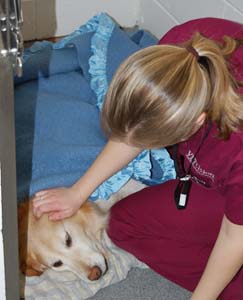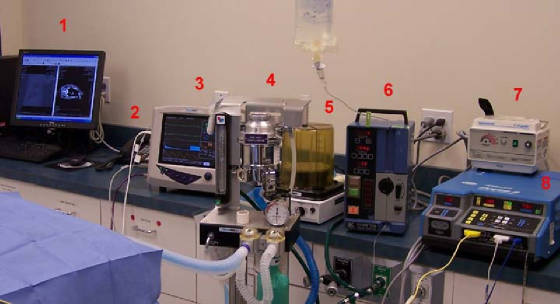Anesthesia
How Our Patients are Anesthetized
Anesthesia at ProFormance Canine includes a multiple drug protocol. Our patients typically receive an intramuscular sedative premedication 20-30 minutes prior to surgery. After the pet is relaxed, an intravenous catheter is placed in a leg vein for fluid and drug administration. An intravenous induction drug is then given through the catheter to effect. This means we only give enough induction drug to get the patient's jaw open to place an endotracheal tube into the airway. We then place all of our stable patients on isoflurane or enflurane anesthetic gas in oxygen. With these inhaled anesthetics we can control our patient's anesthetic depth precisely and rapidly through out the entire surgical or diagnostic procedure. The pet quickly awakens after turning off the anesthesia gas on pure oxygen. All patients at Vetcision Hospitalsare then given one or more medications for pain control intramuscularly, intravenously, intrathecally (around the spine), or topically.
We have special anesthetic protocols for critical patients which may include fewer or additional drugs. These protocols are constantly being reviewed by our consultant veterinary anesthesiologist so we can provide the absolute safest anesthesia.

How Our Patients are Anesthetized
Patient Monitoring and Pain Management
Our highly trained operating room and surgical ICU technicians use the most advanced and safest anesthesia techniques, sophisticated monitoring methods, and thermoregulatory equipment during all of our surgeries. Vetcision Hospitals three surgical suites are equipped with Isoflurane and Sevofluorane inhalant anesthesia. Our monitoring equipment includes ECG, SpO2, end tidal CO2, direct and non-invasive blood pressure, temperature, and visual/tactile methods. We employ the latest pain management techniques and use the safest drug protocols to make your patient's recovery as safe and comfortable as possible. Our SICU technicians constantly monitor patients before and after surgery.

ICU recovery of patients.
At the Head of the Table

1-CT scaon on screen 2-Speaker phone 3-Multi-monitor 4-Anesthetic machine 5-Ventilator 6-IV fluid pump 7-Water heating pad 8-Electrocautery